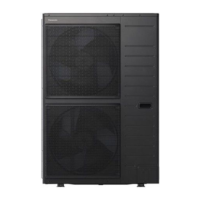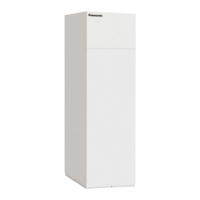
Do you have a question about the Panasonic WH-UXZ09KE5 Series, WH-UXZ12KE5 Series and is the answer not in the manual?
Lists tools needed for installation of the outdoor unit.
Explains warning and caution symbols used on the unit.
Covers general safety precautions, warnings, and cautions for installation and use.
Emphasizes that installation and service must be performed by qualified personnel.
Highlights R32's higher pressure and special tool requirements.
Details the knowledge and skills required for personnel handling refrigerants.
Provides guidelines for installation space and pipework to prevent damage and ensure compliance.
Specifies qualifications and certifications required for service personnel.
Outlines safety checks and procedures before commencing work.
Details how to check for potentially flammable refrigerant atmospheres.
Ensures appropriate fire extinguishing equipment is readily available.
Prohibits ignition sources during servicing to prevent fire or explosion.
Specifies ventilation needs for safe servicing operations.
Lists checks for electrical components and system integrity.
Details initial safety checks for electrical components before servicing.
Guidelines for electrical supply and casing integrity during servicing.
Ensures secure mounting and proper function of seals.
States that replacement parts must meet manufacturer specifications.
Advises on permissible voltage and current for equipment.
Details procedures for working on live intrinsically safe components.
Specifies requirements for test apparatus and replacement parts.
Checks cabling for wear, corrosion, and environmental effects.
Prohibits ignition sources during leak detection.
Lists acceptable methods and sensitivities for leak detection.
Details procedures for breaking into refrigerant circuits for repairs.
Outlines steps for recovering refrigerant and purging the system.
Ensures proper charging equipment and minimal hose length.
Specifies cylinder placement and system earthing during charging.
Warns against overfilling and mandates leak testing.
Advises on dissipating static electricity during charging.
Ensures technician is familiar with equipment before decommissioning.
Requires electrical isolation before commencing decommissioning.
Covers handling of cylinders, recovery equipment, and safe operation.
Advises on dissipating static electricity during decommissioning.
Specifies labelling for de-commissioned and refrigerant-emptied equipment.
Ensures equipment is labelled to indicate it contains flammable refrigerant.
Details safe transfer of refrigerant into designated recovery cylinders.
Specifies requirements for recovery equipment and calibrated scales.
Ensures hoses are leak-free and electrical components are sealed.
Prohibits mixing refrigerants and specifies evacuation for compressor oil.
Advises on awning placement to avoid obstructing heat radiation.
Specifies minimum ambient temperature for installation.
Details required clearances from walls, ceilings, and obstacles.
Warns about environmental factors like sulphur or oily locations shortening lifespan.
Recommends securing the unit against strong wind and earthquakes.
Provides guidelines for adding refrigerant based on piping length.
Illustrates the installation layout and provides essential notes for placement.
Provides instructions for drain elbow usage and freezing precautions.
Details the process of cutting and flaring copper pipes for connections.
Explains how to connect piping, tighten nuts, and seal openings.
Details the step-by-step process for air tightness testing and related notes.
Lists recommended types of leak detectors for the system.
Details correct wire stripping and connection methods to the terminal board.
Specifies insulation requirements for piping and drain hoses.












